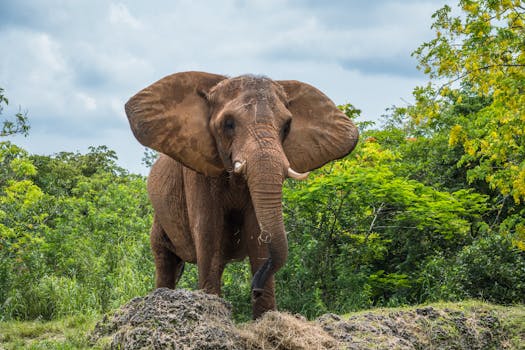Safari Expeditions in Kenya

Kenya's safari expeditions offer an unparalleled glimpse into the heart of Africa’s diverse wildlife and stunning landscapes. Renowned for its rich biodiversity, Kenya provides an array of experiences, from witnessing the Great Migration in the Maasai Mara to exploring the arid expanses of Tsavo. These expeditions are not only about viewing animals but also understanding the intricate ecosystems and conservation efforts that sustain them.
The Maasai Mara: Heart of the Great Migration
The Maasai Mara National Reserve is perhaps Kenya's most famous safari destination, known worldwide for the annual Great Migration. This natural spectacle sees over 1.5 million wildebeest, alongside hundreds of thousands of zebras and gazelles, making their perilous journey across the Mara River.
Visitors to the Maasai Mara can experience this event from July to October, offering a front-row seat to one of nature’s most dramatic displays. The reserve also hosts a significant population of predators, including lions, leopards, and cheetahs, which follow the herds.
Apart from wildlife viewing, the Maasai Mara offers cultural experiences with the Maasai people. These indigenous communities provide insights into their traditional way of life through guided village tours and cultural talks.
Amboseli National Park: The Elephant Paradise
Amboseli National Park is famed for its large elephant herds and stunning views of Mount Kilimanjaro. The park’s diverse habitats, ranging from wetlands to savannahs, support a variety of wildlife species.
One unique aspect of Amboseli is its research on elephant behavior and conservation. Visitors can learn about these majestic creatures through interactions with researchers and conservationists working in the park.
The park’s observation hill provides panoramic views of the entire park and beyond, making it a perfect spot for photography enthusiasts. Amboseli also offers night safaris, giving visitors a chance to see nocturnal animals in their natural habitat.
Tsavo National Parks: The Untamed Wilderness
Comprising Tsavo East and Tsavo West, these parks form one of the largest protected areas in Kenya. Tsavo East is known for its vast open spaces and red elephants, while Tsavo West offers rugged terrain with volcanic landscapes and lush springs.
Tsavo is less crowded than other parks, providing a more secluded safari experience. The Mzima Springs in Tsavo West are particularly popular for their crystal-clear waters where hippos and crocodiles can be observed from underwater viewing hides.
A visit to Tsavo also includes exploring historical sites such as the Lugard Falls and the Shetani Lava Flow, which add a geological dimension to the wildlife safari experience.
Samburu National Reserve: A Unique Ecosystem
Samburu National Reserve offers a different kind of safari experience due to its unique semi-arid ecosystem. It is home to several species not found in other Kenyan parks, such as the Grevy's zebra, Somali ostrich, reticulated giraffe, gerenuk, and Beisa oryx – collectively known as the Samburu Special Five.
The Ewaso Ng'iro River that runs through Samburu attracts a variety of wildlife, making it an excellent spot for game viewing. Additionally, Samburu's landscape features dramatic escarpments and acacia trees that add to its scenic beauty.
Cultural interactions with the Samburu people are another highlight here. Their rich traditions and colorful attire offer a fascinating cultural perspective that complements the wildlife experience.
Practical Tips for Safari Expeditions
- Best Time to Visit: While safaris can be enjoyed year-round, dry seasons (June to October) are generally considered best for game viewing.
- Packing Essentials: Lightweight clothing in neutral colors, binoculars, camera gear with extra batteries, sunscreen, insect repellent, and a good field guide are essential items.
- Health Precautions: Consult your healthcare provider about vaccinations and medications for malaria prophylaxis before traveling.
- Respect Wildlife: Always follow your guide’s instructions and maintain a safe distance from animals to ensure both your safety and theirs.
Safari Destinations Comparison Table
| Destination | Key Features | Best Time to Visit | Unique Experiences |
|---|---|---|---|
| Maasai Mara | Great Migration, Big Cats | July - October | Cultural Tours with Maasai People |
| Amboseli | Elephants, Mount Kilimanjaro Views | June - October | Night Safaris |
| Tsavo East & West | Red Elephants, Volcanic Landscapes | May - October | Mzima Springs Underwater Viewing |
| Samburu | Samburu Special Five | June - October | Cultural Interactions with Samburu People |
The Role of Conservation Efforts in Kenya’s Safaris
Sustainable tourism is crucial for preserving Kenya’s wildlife heritage. Many safari operators collaborate with conservation organizations to protect endangered species and habitats. For instance, the David Sheldrick Wildlife Trust focuses on rescuing orphaned elephants and reintegrating them into the wild (Sheldrick Wildlife Trust Website). Similarly, organizations like Rhino Ark work on preserving critical ecosystems within Kenya's Aberdare National Park (Rhino Ark Website).
Kahumbu’s extensive background includes her role as CEO of WildlifeDirect and her efforts in leading campaigns against poaching. Her insights offer valuable perspectives on how integrated approaches involving local communities can lead to sustainable conservation outcomes.
A safari expedition in Kenya is an immersive experience into some of Earth's most remarkable ecosystems. From witnessing spectacular migrations in Maasai Mara to engaging with local cultures in Samburu, each destination offers unique encounters that leave lasting impressions.